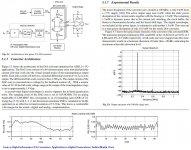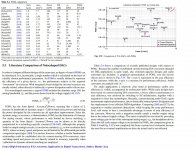Is there any other point to this how many bits discussion except for wishful thinking?
It's easy to agree more bits would be fine, nut as Frank pointed out quite rightly, more bits does NOT automatically mean better sound. As we all know from our 16 current crop, most still haven't mastered even that technology. Even 16 bits can sound impressive, but doesn't far too often.
It's easy to agree more bits would be fine, nut as Frank pointed out quite rightly, more bits does NOT automatically mean better sound. As we all know from our 16 current crop, most still haven't mastered even that technology. Even 16 bits can sound impressive, but doesn't far too often.
There is more to it..... Take a look at BenchMark-Two and how they use the multiple 32b DAC and DSP to get more dynamic range and lower distortion at mid and low level (detail, clarity, realism).
-RNM
besides issues like down conversion errors from 24 to 16 and other issues like jitter and so on..... One point is --- A simple distortion comparison of any low level 16 bit and 24 bit is what seems to me make a difference/improvement that I easily hear.
View attachment 470281
OR
View attachment 470282
Dither, as Wrinkle said.
Now run both through the output filter - how does it look then?
Jan
There is more to it..... Take a look at BenchMark-Two and how they use the multiple 32b DAC and DSP to get more dynamic range and lower distortion at mid and low level (detail, clarity, realism).
I don't see four Sabre D/A ICs there, just one. Maybe the other three are on the other side of PCB?
What I do see is SRC4392 sample rate converter on the input (that makes two SRC processes now), switcher PSU and a lot of lovely ceramic caps. All purist audiophile stuff..

Benchmark DAC2 HGC impressions (and Linux setup notes) - 4season - Digital Drive
That is the 'oil' i refered to.
THx-RNMarsh
No blood and offal. You need a pretty large Thai expat community here making food essentially for each other to get it.
that looks like undithered 16 bit to me.
Yes, Dick just has no interest in understanding the technology.
I don't see four Sabre D/A ICs there, just one. Maybe the other three are on the other side of PCB?
What I do see is SRC4392 sample rate converter on the input (that makes two SRC processes now)
Yup, right from SRC4392 DS data sheet, "accepts up to 24 bit audio data". Specs are right on 24 bit numerical noise.
OK, thanks. What this basically mean is that enyone else who's going to use this chip for 2 tracks will also use remaining six channels in one way or another. No need to toot marketing horn about multiple D/As per channel as if it is something unique.8-channel
Oh ! Don't you ever had Alnico speakers ?Yes, I knew it was ironic
Just supposing you wanted 22Khz bandwidth and 28 bit resolution, you would need to dissipate at least 26 watts in the D/A to keep the noise floor below the bits...
Wrinkle
Can you please elaborate on the calculations over bit depth, bandwidth and power dissipation on a DAC?
I have looked at many DAC data sheets and I don’t see high W numbers.
In the first attachment, there are some relevant detailed numbers from a 14bit multibit Sigma Delta DAC (It is not for audio applications, working intentionally with fold-back alliasing components, but the issue you are raising should hold along any Nyquist zone operation).
In the second attachment there are some Power/Dynamic Range/Bandwidth comparisons from (mostly) Audio DACs
We still need more bits to lower distortion.... even if they run down into the noise for some bits
Distortion in ADCs or DACs in practice, does not have to do only (or not at all) with number of bits. (e.g. Integral and Differential Nonlinearity Distortion Effects)
Yep, trivial. But pretty much a dc application.
There was no offense taken..how could there be??
(Chapter 3, pages 159-162)
ADI - Analog Dialogue | Data Conversion Handbook
Segmented DACs
So far we have considered basic DAC architectures. When we are required to design a DAC with a specific performance, it may well be that no single architecture is ideal. In such cases, two or more DACs may be combined in a single higher resolution DAC to give the required performance. These DACs may be of the same type or of different types and need not each have the same resolution.
In principle, one DAC handles the MSBs, another handles the LSBs, and their outputs are added in some way.
The process is known as “segmentation,” and these more complex structures are called “segmented
DACs.” There are many different types of segmented DACs and some, but by no means all, of them will be illustrated in the next few diagrams.
There is no restriction to DC applications only.
The technique is used to build logarithmic DACs too.
George
Attachments
I have looked at many DAC data sheets and I don’t see high W numbers.
Which datasheets did you find for DACs with 28bit noise floors (-170dB) ? I rather suspect wrinkle's making the point that the thermal noise floor is going to demand high currents into low impedances to get the SNR up to 170dB.
Yes, Dick just has no interest in understanding the technology.
Yeah. It's one thing to be ignorant. But willful ignorance is inexcusable.
se
Which datasheets did you find for DACs with 28bit noise floors (-170dB) ?
None.
I have found ADCs from 8 up to 24 bits and DACs from 8 to 20bits
From these, I don’t see a steep power consumption escalation vs bit depth .
I can see though important changes due to DACs architecture.
I rather suspect wrinkle's making the point that the thermal noise floor is going to demand high currents into low impedances to get the SNR up to 170dB
Maybe.
I miss the theory, that’s why I asked Wrinkle if he could provide some info
George
Last edited:
Probably using electronic parts made in mainland China ..The difficult parts of the space arm were designed in the US (says the guy who designed the touch sensors for the fingers).
Yeah, blame Canada!Canadians have beady eyes and floppy heads. And they are addicted to Terence and Phillip.
http://www.youtube.com/watch?v=5CTvjwt1bvY
Distortion in ADCs or DACs in practice, does not have to do only (or not at all) with number of bits. (e.g. Integral and Differential Nonlinearity Distortion Effects)
Yup, quantization error is an additive processes not transfer function linearity related. In practice the INL and DNL limit the performance and more bits do nothing.
The quantization error is decorrelated by dither, first principles stuff no need to go there again.
Last edited:
first principles stuff no need to go there again.
Judging from myself, the “first principles stuff” is always the easiest to overlook, misunderstand or both.
As to ADCs/DACs fundamentals and details, there is a lot of things I had (have) to read again and again for to understand them properly.
Questions and explanations from members here help.
George
Wrinkle
In the first attachment, there are some relevant detailed numbers from a 14bit multibit Sigma Delta DAC (It is not for audio applications, working intentionally with fold-back alliasing components, but the issue you are raising should hold along any Nyquist zone operation).
In the second attachment there are some Power/Dynamic Range/Bandwidth comparisons from (mostly) Audio DACs
Distortion in ADCs or DACs in practice, does not have to do only (or not at all) with number of bits. (e.g. Integral and Differential Nonlinearity Distortion Effects)
George
Finally, some good info! A lot of assumptions about what I know or dont know or want to know or what I have measued. What I do not want is the same old stuff.
Of course there are many, many details.... none I want to rehash, though. The main difference that I hear between excellently executed designs of 16 and 24b though is the Bits.
Others will have to dispute that for and to themselves.
Maybe it would be possible to do better with another topology, such as those you indicated/show? Can that be done on the DAC side for audio?
THx-RNMarsh
Last edited:
Of course there are many, many details.... none I want to rehash, though. The main difference that I hear between excellently executed designs of 16 and 24b though is the Bits.
THx-RNMarsh
I haven't seen you mention an apples to apples comparison yet. just comparing different masterings. Not sure there is proof that it is the bits? But guess you are convinced it must be the bits?
http://www.ti.com/lit/an/slaa013/slaa013.pdf
An excellent treatise on data converters for anyone wondering what some folks are hemming and hawing about.
I guess the better question is: are newer, high-bit DAC/ADCs simply more linear than their predecessors? Those nonlinearities can very easily swamp the entire difference between 16 and (ostensible) 24 bit depth.
An excellent treatise on data converters for anyone wondering what some folks are hemming and hawing about.
I guess the better question is: are newer, high-bit DAC/ADCs simply more linear than their predecessors? Those nonlinearities can very easily swamp the entire difference between 16 and (ostensible) 24 bit depth.
- Status
- Not open for further replies.
- Home
- Member Areas
- The Lounge
- John Curl's Blowtorch preamplifier part II

